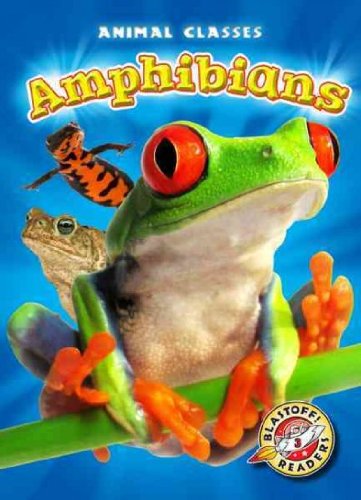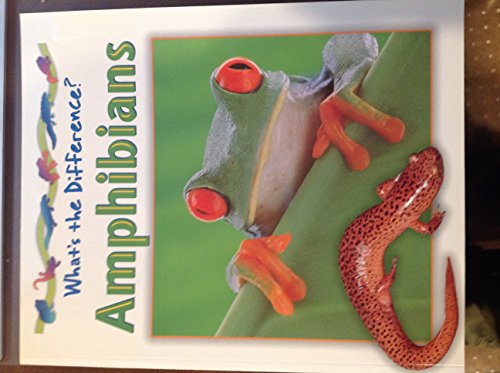-
Amphibians
Kari Schuetz
Library Binding (Blastoff Reader, Aug. 1, 2012)"Simple text and full-color photography introduce beginning readers to amphibians. Developed by literacy experts for students in kindergarten through third grade"--Provided by publisher. J
J
-
Amphibians
Stephen Savage
Paperback (Heinemann/Raintree, May 1, 2000)Describes the physical characteristics common to amphibians and highlights differences among various species, discussing habitats, methods of getting around, feeding habits, and how amphibians reproduce. M
M
-
Amphibians
Angela Royston
Paperback (Heinemann, Jan. 1, 2015)This book is all about amphibians: what they do, how they behave, and how these characteristics are different from other groups of animals. Beautifully illustrated with colorful photographs, the book shows many examples of different types of amphibians in their natural environment. N
N
-
Amphibians
Kristen Rajczak Nelson
Library Binding (Enslow Publishing, Jan. 15, 2019)All amphibians spend part of their life on land and part in the water. What part and for how long varies between species. In this engaging and colorful text, readers learn the main characteristics that make an animal part of the amphibian group and the many unique adaptations that can occur within the bounds of that characteristic. With main content supporting the Next Generation Science Standards core ideas of adaptation, ecosystems, and biodiversity, this book is a great introduction to one of the many animal groups on Earth. M
M
-
Amphibian
Barry Clarke
Hardcover (DK Children, Sept. 5, 2005)Frogs, toads, newts, salamanders, and the rare caecilians come in a stunning array of colors, shapes, sizes, and habitats. They live both in water and on land and move in a variety of ways from swimming to hopping and even flying. With a series of specially commissioned photographs, DK Eyewitness Books: Amphibian takes a close look at the fascinating natural history of these creatures from the bright green, red-eyed tree frogs to dull, burrowing, wormlike caecilians; from startling black and yellow fire salamanders to tiny transparent glass frogs. The most trusted nonfiction series on the market, Eyewitness Books provide an in-depth, comprehensive look at their subjects with a unique integration of words and pictures. X
X
-
Amphibians
Erica Donner
Paperback (Bullfrog Books, Jan. 1, 2017)In Amphibians, early readers learn about the defining characteristics of this animal group. Vibrant, full-color photos and carefully leveled text will engage early readers as they discover what features set these animals apart. G
G
-
Amphibians' End
Trevor Pryce, Sanford Greene
Paperback (Amulet Paperbacks, July 12, 2016)Watch the Netflix original series based on the books starting September 4, 2016! The future of the Amphibilands has never looked so bleak. With Lord Marmoo still maniacally bent on taking over the outback, Darel can’t fathom why the Rainbow Serpent wants him to lower the Veil, the Amphibilands’ only source of protection. But the Serpent’s message is clear, and in preparation for the inevitable battle, Darel and the Kulipari go in search of someone—anyone—to fight on their side. In their travels, the frog warriors make a perilous discovery: the outback’s water supplies are mysteriously disappearing. With the odds stacked against them, Darel and the Kulipari must take one final stand to protect their home, before it becomes . . . the Arachnilands. The Kulipari trilogy comes to its thrilling conclusion in this action-packed adventure by Trevor Pryce and acclaimed comics artist Sanford Greene. Z+
Z+
-
Amphibians
Adele D. Richardson
Library Binding (Capstone Press, Sept. 1, 2004)Discusses the characteristics, eating habits, and offspring of amphibians, one of the main groups in the animal kingdom. M
M
-
Amphibians
Christine Taylor-Butler
Paperback (Children's Press, Sept. 1, 2013)From tiny, colorful tree frogs to the giant salamanders that burrow along the riverbanks of Japan, there are more than 7,000 amphibian species living on our planet today.A True Book: Animal Kingdom series introduces young investigative readers to animal species, their habitats, unique abilities as well as an up-close look at the dangers these animals face today and find out how humans can help keep all animal species from disappearing forever. This series includes an age appropriate (grades 3-5) introduction to curriculum-relevant subjects and a robust resource section that encourages independent study. Readers will discover how these incredible animals live double lives, spending time both on land and underwater. They will also find out how amphibians search for food and reproduce, as well as what dangers are facing these species today. Q
Q
-
Amphibians
Brian Cassie
Hardcover (Scholastic, Aug. 1, 1999)Explores the world of amphibians, discussing their classification, anatomy, behavior, and habitat, and providing photographs and detailed descriptions of individual species W
W
-
Amphibians
Barbara Alpert
eBook (Compass Publishing, Oct. 31, 2013)Frogs, toads, and newts are amphibians, which mean that they live both in water and on land. Read about the life cycle, appearance, and behavior of this strange, unique group of animals.
-
Amphibians
Tom Evans
language (World Book, Inc., June 13, 2018)Which frog is more poisonous than the deadliest snake? Why do toads have bumpy skin? How are amphibians related to fish? Why are some amphibians endangered, and what can we do to protect them? Amphibians provides readers an introduction to amphibians and their physical characteristics. Students learn about their life cycle, behaviors, and adaptations to various habitats. The volume’s special features include maps, diagrams, fun facts, glossary, resource list, and index.How do animals hunt, escape, and communicate? And how do scientists distinguish one animal group from another? World Book’s acclaimed Animal Lives series introduces the main animal groups to students with a primary reading level of grades 3 to 5 and teaches them basic principles of scientific classification.